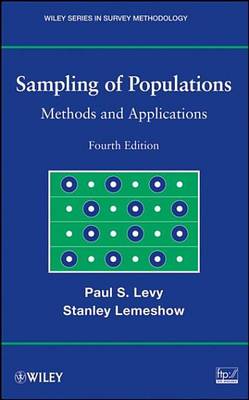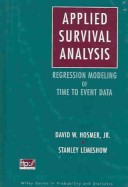Wiley Series in Probability and Statistics
4 total works
Keeping mathematical jargon and formality to a minimum, this text explores the basic concepts, methods and techniques of sampling. As well as "classical" sample designs, it explores a host of recently developed techniques for network sampling, small area and prevalence estimation, estimation of standard errors in complex surveys, and many others. Statistical issues are presented heuristically and explained with the aid of commonly encountered real-life examples applicable to any field where sampling surveys are used.
From the reviews of the First Edition: "An interesting, useful, and well-written book on logistic regression models...Hosmer and Lemeshow have used very little mathematics, have presented difficult concepts heuristically and through illustrative examples, and have included references." - "Choice". "Well written, clearly organized, and comprehensive...the authors carefully walk the reader through the estimation of interpretation of coefficients from a wide variety of logistic regression models...their careful explication of the quantitative re-expression of coefficients from these various models is excellent." - "Contemporary Sociology". "An extremely well-written book that will certainly prove an invaluable acquisition to the practicing statistician who finds other literature on analysis of discrete data hard to follow or heavily theoretical." - "The Statistician". In this revised and updated edition of their popular book, David Hosmer and Stanley Lemeshow continue to provide an amazingly accessible introduction to the logistic regression model while incorporating advances of the last decade, including a variety of software packages for the analysis of data sets.
Hosmer and Lemeshow extend the discussion from biostatistics and epidemiology to cutting-edge applications in data mining and machine learning, guiding readers step-by-step through the use of modeling techniques for dichotomous data in diverse fields. Ample new topics and expanded discussions of existing material are accompanied by a wealth of real-world examples - with extensive data sets available over the Internet.
Hosmer and Lemeshow extend the discussion from biostatistics and epidemiology to cutting-edge applications in data mining and machine learning, guiding readers step-by-step through the use of modeling techniques for dichotomous data in diverse fields. Ample new topics and expanded discussions of existing material are accompanied by a wealth of real-world examples - with extensive data sets available over the Internet.
This is a practical, up to date guide to modern methods in the analysis of time to event data. The rapid proliferation of powerful and affordable statistical software packages over the past decade has inspired the development of an array of valuable new methods for analyzing survival time data. Yet there continues to be a paucity of statistical modeling guides geared to the concerns of health related researchers who study time to event data. This book helps bridge this important gap in the literature. "Applied Survival Analysis" is a comprehensive introduction to regression modeling for time to event data used in epidemiological, biostatistical, and other health related research. Unlike other texts on the subject, it focuses almost exclusively on practical applications rather than mathematical theory and offers clear, accessible presentations of modern modeling techniques supplemented with real world examples and case studies. While the authors emphasize the proportional hazards model, descriptive methods and parametric models are also considered in some detail.
Key topics covered in depth include: Variable selection; Identification of the scale of continuous covariates; The role of interactions in the model; Interpretation of a fitted model; Assessment of fit and model assumptions; Regression diagnostics; Recurrent event models, frailty models, and additive models; and, Commercially available statistical software and getting the most out of it. "Applied Survival Analysis" is an ideal introduction for graduate students in biostatistics and epidemiology, as well as researchers in health related fields.
Key topics covered in depth include: Variable selection; Identification of the scale of continuous covariates; The role of interactions in the model; Interpretation of a fitted model; Assessment of fit and model assumptions; Regression diagnostics; Recurrent event models, frailty models, and additive models; and, Commercially available statistical software and getting the most out of it. "Applied Survival Analysis" is an ideal introduction for graduate students in biostatistics and epidemiology, as well as researchers in health related fields.


